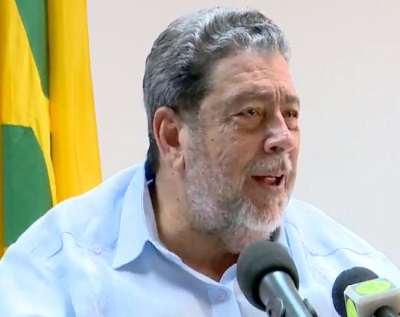
Fri, Nov 27, 2020
Over the last 20 years of the Unity Labour Party administration, this country has seen an unprecedented number of weather events that have wreaked havoc on the physical infrastructure of this country, caused unspeakable tragedy and disrupted the lives of thousands of Vincentians for extended periods. As a reminder of some of those occurrences, we can go back to: 2010, the year of hurricane Tomas in October, that destroyed a number of homes and downed power-lines, caused Major flooding and landslides throughout the country; the December 2013 floods caused by a trough system that dumped over 20 inches of rainfall on this island in less than 24 hours, damaging approximately 17% of our country’s Gross Domestic Product (GDP) and taking the lives of 13 Vincentians, including a family of 3 in the North Eastern village of Rose Bank; and most recently, the drought of 2020 that was the worst in almost a century.
These are just three of the major events, as there were other storms and other instances of persistent rainfall that caused damage to property and infrastructure across this country. These events remind us of our peculiar vulnerabilities as Small Island Developing States that sit on the very frontlines of the global climate crisis.
Based on the challenges this country has faced in dealing with the impacts of climate change, and the warnings that things are not likely to get better based on the failure of the world’s largest carbon dioxide emitters to take decisive action, the government has shown its intent to ensure that rebuilding and reconstruction would be done to ensure resilience, building back better and stronger.
Building Back Better and Stronger
One aspect of this country’s physical infrastructure that has taken a significant beating over the period is bridges, cutting off communities and causing significant inconveniences to the travelling public. The ULP, with the construction of the bridge at Rabacca, has proven itself as being capable to handle large projects of this kind previously thought impossible.
After the December 13 floods, a number of bridges across the country from Fitz Hughes to Langley Park, were left in various degrees of disrepair, from marginal damage to complete destruction.
In the Georgetown area alone, three bridges were severely or completely damaged: the Mt Young bridge, the Caratal bridge and the bridge at Langley Park; significant infrastructural damage for just one community. In Chateaubelair, damage was sustained to bridges in Fitz Hughes, Golden Grove, and Sharps Village, with extensive damage to the bridge at Spring Village making it unusable. To replace these bridges the ULP administration led by Comrade Ralph moved swiftly to mobilise financial resources from some of the usual institutional partners, but also used our progressive foreign policy to negotiate assistance from our allies.
What took place over the subsequent years was a reconstruction drive that saw the replacement of a number of bridges in Spring Village in North Leeward, Vermont, Mt. Young, Caratal and Langley Park. In every instance, the bridges were widened so two-lane traffic can be easily accommodated; they were raised higher (the Caratal bridge being the most obvious example of this) and more reinforcement used in construction material showing columns four times the dimensions of what existed previously. These visible, structural characteristics of the bridges depict the emphasis placed on constructing bridges that are climate resilient, to withstand weather events of the magnitude of the 2013 floods and greater.
The reconstruction of these bridges cost the government tens of millions of dollars, raised through loans and other instruments, as well as through technical assistance from the government of Ecuador that also supplied Bailey bridges that were used temporarily in some instances. The cost of reconstruction was great and the process of mobilising funding slow, but today SVG has a bridge network that would rank among the most resilient among SIDS anywhere in the world.
The Vision of SVG’s Contingency Fund
The repeated lessons from resource mobilisation after the passage of a storm or other types of natural disasters teach us that having to turn to external sources can be slow, because of various levels of bureaucracy. This government recognised that there must be something in place that gives this country an immediate source of funds that can be used to begin reconstruction or at the basic, clean up work as well as assisting families impacted in the days immediately following a disaster. To achieve this, the government in 2018 introduced a hotel levy on nightly stay for visitors, of EC$3 with the sole purpose of creating a contingency fund that would be an immediate source of funds to respond to the impacts of natural disasters.
By early 2020, that fund had already accumulated in excess of $33 million that could be used for national disaster response. Very importantly, the presence of this contingency fund gave the government a source of funds that was used to form part of the relief package to assist Vincentians who lost their jobs as a result of the Covid-19 pandemic. It is also worth noting that the Parliamentary opposition in its usual obstructionist fashion opposed the contingency fund, claiming erroneously that its introduction would “kill” the tourism industry. Needless to say, our tourism product pre covid-19, was stronger than it had ever been and much growth is anticipated post-Covid-19.
Conclusion
This country’s quest to ensure that we build a country with infrastructure that is resilient against the impact of climate change continues in this the historic 5th term of the ULP administration. Every effort will be made to ensure that our roads and bridges are constructed in a manner that allows them to withstand the harsh weather events that have been a feature within recent years in this region.
The government also continues its work on sea and river defence, with work ongoing in Georgetown, San Souci and expected to begin in Sandy Bay. The very important contingency fund will continue to play its role in making local funds immediately available in the event of these unfortunate and unpredictable weather events. Building a resilient SVG is very much a part of us lifting SVG higher.






